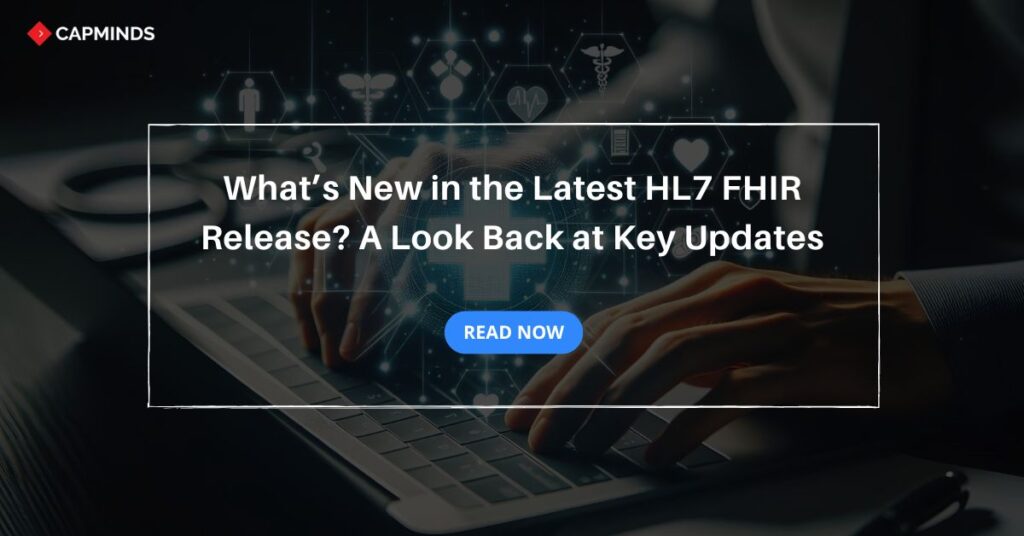What’s New in the Latest HL7 FHIR Release? A Look Back at Key Updates
The Health Level Seven International (HL7) has made significant strides in healthcare interoperability with the release of the first normative version of its Fast Healthcare Interoperability Resources (FHIR) standard—version 5. The latest FHIR releases empower healthcare providers by facilitating standardized access to comprehensive patient records and offering robust support for innovative applications.
This blog explores the origins, development milestones, and impact of HL7 FHIR, highlighting its pivotal role in enhancing data interchange and interoperability in healthcare systems.
The Origins and Purpose of HL7 FHIR
Fast Healthcare Interoperability Resources (FHIR) was created to fulfill the requirement for seamless data interchange in healthcare. It is a widely used health interoperability standard that is specifically developed for health information exchange.
HL7 is for Health Level Seven, while FHIR stands for Fast Healthcare Interoperability Resource.
The primary goal of HL7 FHIR is to allow health information (clinical and administrative data) to be successfully shared across healthcare practitioners. Using HL7 FHIR, practitioners can:
- Improve the interoperability and data exchange between healthcare systems.
- Standard data format based on web technologies
- Resource-based architecture for effective data management.
- Extendibility to fit specific organizational needs
- Increased accessibility and it is scalable.
By focusing on web-based technologies, FHIR enables more agile and accessible interactions within healthcare systems.
Related: 5 Challenges Associated with HL7 FHIR and How CapMinds Helps to Solve
Key Milestones in FHIR Development
HL7 FHIR has seen significant development through each release, progressively refining interoperability and stability.
FHIR Release 4 (2019)
- Marked a major milestone by offering a normative base for several resources.
- Provided a stable framework for resources such as Patient, Observation, and Practitioner.
- Signified that these core resources would remain backward-compatible in future updates.
FHIR Release 4B (2021)
- Focused on smaller adjustments to improve existing resources.
- Introduced slight changes without disrupting the core framework established in Release 4.
- Aimed to provide refinements rather than significant overhauls.
FHIR Release 5 (Latest):
- Brought further enhancements and new resources, building on the stability of previous releases.
- Introduced updates to resource maturity, expanding its applicability.
- Further refined standards to improve implementation consistency and adaptability.
Evolution and Stability: FHIR’s Levels of Maturity
FHIR’s maturity levels indicate the level of testing, stability, and reliability of different resources in real-world implementations.
Maturity Levels (FMM 0-6)
- FMM 0: Early stages, minimal testing.
- FMM 1-2: Developmental testing and feedback, not yet broadly implemented.
- FMM 3-4: Tested in practical scenarios, deemed reliable for certain use cases.
- FMM 5-6: Matured resources, highly stable, and suitable for critical applications.
Standards Status
- Normative: Fully tested and widely adopted, with backward compatibility assured.
- Trial Use: Ready for practical applications but may undergo adjustments based on feedback.
- Draft: Early developmental stages, primarily for internal review and testing.
Stability and Change Management
- FHIR’s change management process ensures stable releases and manages updates based on a structured versioning model.
- Changes to normative resources are carefully managed to maintain backward compatibility.
Related: 10 Reasons Why You Need CapMinds’ HL7 FHIR Service for Your Practice
The Impact of FHIR Releases on Implementation
Each FHIR release significantly influences healthcare system implementation by enhancing compatibility, resource availability, and overall stability.
New Resources
- Each release introduces additional resources tailored to specific healthcare requirements.
- For instance, recent releases have added resources for social determinants of health.
- So, it enables organizations to better address holistic patient needs.
Backward Compatibility
- One of the critical features of FHIR is its commitment to backward compatibility.
- This principle ensures that existing systems leveraging normative resources are not disrupted by new updates.
- Developers can confidently integrate the latest releases.
- Knowing that their current systems will remain functional without requiring extensive rework.
Maturity Improvement
- As resources mature through various FHIR maturity levels.
- Developers gain access to tested and reliable tools.
- This stability allows for a more efficient implementation process.
- So, the team can focus on enhancing functionality and meeting industry standards rather than dealing with unstable resources.
- Overall, FHIR releases foster a robust and adaptive environment for healthcare technology.
The Versioning Model of FHIR
FHIR follows a structured versioning model to maintain consistency and manage changes effectively.
- Each FHIR version is assigned a unique identifier to indicate significant and minor updates.
- Major versions introduce extensive changes and new resources, while minor versions focus on refinements.
- New releases are scheduled based on the necessity for updates, balancing stability with innovation.
- This cycle allows developers to anticipate updates and adjust implementations accordingly.
CapMinds HL7 FHIR Service for your practice
CapMinds offers the best all-in-one health interoperability solution for healthcare practices. Our HL7 FHIR service will understand your clinical needs and requirements to cater to our solution.
We have years of experience in this field faced many challenges and tackled them with ease. Why can CapMinds be your Go-to Interoperability Solution?
- We are experienced professionals with years of experience in the field.
- Our technical team is an expert who will analyze your healthcare practice thoroughly to tailor the Interoperability solution.
- We prioritize safety, security, encryption, and authentication to protect your healthcare practice patient’s data.
- Our comprehensive solution ensures seamless interoperability adhering to industry standards, and using standard protocols.
- We offer comprehensive training sessions to healthcare staff.
- Our affordable health interoperability solution benefits healthcare practice at all levels.
If you are searching for the best interoperability service for your practice, CapMinds is your choice. We can assist you by navigating all potential challenges and ensuring seamless health data exchange.
Reach out to CapMinds Health Data Exchange Solutions for your Healthcare Practice.



